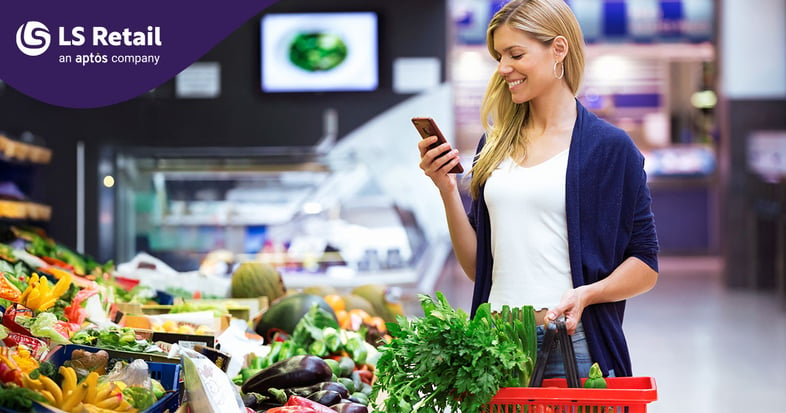
A shopper enters a local grocery store, fills their basket and departs, bypassing long checkout lines with nothing more than their paid for goods and smartphone in hand. Within a matter of minutes, they’ve been able to grab items off the shelves, scan them as they go, and pay instantly – no waiting, no hassle. This quick and uninterrupted shopping experience is no longer a futuristic concept. It’s now a reality as grocery retailers adopt technologies such as mobile self-scanning and AI-powered inventory systems.
According to Deloitte, automation and AI are fast becoming essential in how supermarkets manage everything from stock levels to personalized shopping experiences. More than three-quarters of grocery executives anticipate that technology-driven, real-time inventory tracking will be standard in the next 5 to 10 years, while almost nine in ten say the marketing of groceries will become hyper-personalized. These advancements are paving the way for a new era in grocery shopping: one that connects convenience, sustainability, and efficiency in ways that weren’t possible before.
Here are six trends defining the future of supermarkets and grocery stores, making shopping smarter, faster, and more tailored to individual consumer needs:
1. Faster shopping with mobile self-scanning
The global market for self-checkout solutions is projected to grow significantly (reaching a market value of USD18.01 billion by 2032), driven by demand for faster and contactless shopping. Modern consumers value speed and autonomy, making self-scanning and checkout-free solutions an increasingly popular option among retailers. These apps allow shoppers to scan for items directly on their smartphones, manage their own shopping lists, track their total, and pay digitally. This reduces wait times, enhances convenience, and lets retailers focus on offering a great in-store experience.
Many grocery retailers have already implemented these solutions into their stores. Take Icelandic grocery store, Bonús, for example, which uses ScanPayGo in its physical locations. Since introducing this option using retail-provided scanning devices, Bonús has improved consumer loyalty and increased basket sizes as customers feel more in control of their shopping.
2. Sustainability as a core value
Sustainability has been on the agenda for grocery stores for years, but today the focus is shifting toward more innovative and ambitious approaches. Beyond reducing plastic packaging and encouraging recycling, many retailers are now embracing the concept of the circular economy, where waste is minimized through the continuous reuse of resources. Many grocery retailers are doing this by:
- Offering local, organic, and zero-waste products
- Reducing energy consumption with smart refrigeration and lighting systems
- Digitalizing receipts and promotions to cut paper waste
Not only that, but an increasing number of grocery retailers are turning to innovative software solutions to tackle food waste. These tools help them monitor fresh products that spoil quickly and packaged goods with set expiration dates, providing a clear picture of how often items sell before going bad. Armed with these insights, retailers can make smarter, sustainability-focused decisions, ensuring shelves are stocked with the right products while avoiding overstocking goods.
3. Hyper-personalization through data insights
Personalization is key to keeping shoppers engaged no matter where they are – even in grocery stores. By analyzing purchase history, supermarkets can recommend tailored product suggestions, such as gluten-free snacks for customers with dietary preferences or promotions on frequently purchased items like coffee or fresh produce. Loyalty programs and apps allow retailers to track preferences in real-time, enabling features like digital coupons for favorite brands or custom meal-planning ideas based on past purchases.
Some stores even use geolocation data to send personalized offers as customers approach specific aisles. For instance, a shopper who often buys organic produce might receive a notification about a sale on organic avocados while in the produce section. These strategies enhance convenience, build customer loyalty, and create a shopping experience that feels unique to everyone.
4. Omnichannel shopping and delivery options
Almost half of shoppers purchase between 25% and 50% of their groceries online, underscoring the growing importance of eCommerce in the grocery industry. However, consumers are not abandoning in-store shopping entirely; instead, they are blending digital and physical channels to suit their preferences.
Many stores, for example, offer curbside pickup, enabling shoppers to place orders online and collect them at their convenience. Home delivery services, often in collaboration with platforms like Instacart, bring groceries straight to customers' doors. But to manage these operations effectively, grocery and supermarket retailers should rely on comprehensive retail management software like LS Central. These platforms provide a unified view of inventory, orders, and customer interactions across all channels, ensuring smooth operations.
Take the specialty grocery chain, Freshmart as an example. With LS Central’s powerful capabilities, the company now enjoys easy management of delivery, eCommerce, drive-thru, and pick up services all on the same platform.
5. AI-powered inventory and pricing optimization
AI and machine learning are transforming how grocery stores and supermarkets manage inventory and pricing. Retail Gazette reported that retailers using AI-driven inventory tools have seen a reduction in stockouts by up to 50% and a 30% increase in inventory turnover.
Predictive analytics powered by AI can forecast demand with high accuracy, helping retailers stock the right products in the right quantities while minimizing waste. For example, AI tools analyze historical sales data, weather patterns, and local events to anticipate spikes in demand for seasonal or perishable items like ice cream during heatwaves or party snacks before major sporting events. On the pricing side, AI-driven dynamic pricing systems, such as digital price tags, allow retailers to adjust prices in real time based on factors such as competitor pricing, demand fluctuations, and inventory levels.
For instance, if a particular brand of milk is overstocked, AI can suggest temporary price reductions to encourage sales. Additionally, AI helps identify patterns in customer behavior, enabling personalized discounts and promotions that align with shopping habits to boost revenue.
6. In-store experiences that drive loyalty
Despite the rise of online shopping, physical grocery stores remain central to the customer experience. Today’s supermarkets are incorporating features like cooking demonstrations, taste tests, and interactive displays to create memorable experiences. Some stores have introduced sampling stations or tasting bars where customers can try gourmet cheeses, wines, or new snack options, creating a sense of discovery and connection to the brand.
Technology plays a role, too, with smart shopping carts and mobile apps that guide customers through personalized deals or suggest complementary items as they shop. For example, a shopper buying pasta might receive a recipe recommendation for spaghetti carbonara and a discount on Parmesan cheese. Additionally, stores are investing in community spaces, such as in-store cafes or family-friendly zones, encouraging their shoppers to linger and spend more time with the brand.
Keep pace with the latest grocery retail trends
As grocery retail evolves, technology is essential for staying competitive and meeting ever-changing customer expectations. Innovative solutions like LS Central and ScanPayGo empower grocers and supermarkets to unify operations, reduce friction, and focus on creating exceptional customer experiences.
Don’t just adapt to change, lead it. Contact us and discover how LS Retail can transform and future-proof your grocery business for the demands of today and tomorrow.

